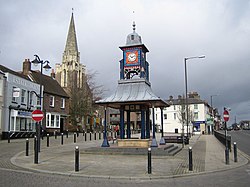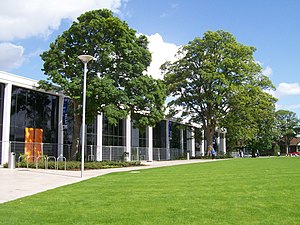Dunstable
| Dunstable | |
| Bedfordshire | |
|---|---|
 The Clock Tower and Market Cross | |
| Location | |
| Grid reference: | TL0121 |
| Location: | 51°53’10"N, -0°31’16"W |
| Data | |
| Population: | 33,805 (2001) |
| Post town: | Dunstable |
| Postcode: | LU5, LU6 |
| Dialling code: | 01582 |
| Local Government | |
| Council: | Central Bedfordshire |
| Parliamentary constituency: |
South West Bedfordshire |
Dunstable is a market town in southern Bedfordshire, adjacent to the border with Hertfordshire. It lies on the eastward tail spurs of the Chiltern Hills, which form several steep chalk escarpments most noticeable when approaching Dunstable from the north. The town stands where two ancient routes cross; Watling Street, the Roman Road from London to North Wales, and the Icknield Way.
The oldest part of the town is along the Icknield Way and Watling Street.
Etymology
In Roman times the town's name was Durocobrivis or possibly Durocobrivae. [1]
There are several theories and local legends concerning the town's modern name:
- Legend tells that the lawlessness of the time was personified in a thief called Dun. Wishing to capture Dun, the King stapled his ring to a post daring the robber to steal it. It was, and was subsequently traced to the house of the widow Dun. Her son, the robber, was taken and hanged to the final satisfaction that the new community bore his name.[2]
- From the Anglo-Saxon for "the boundary post of Duna".[2][3]
- From Dun, a hill, and Staple, a marketplace.[4]
History
Ancient history
Palæolithic relics have been found. At Maidenbower in the parish of Houghton Regis to the north, is an Iron Age hill fort, however remains are also visible of what appears to have been an earlier Bronze Age fort on the site.
Roman settlement
There was already some form of settlement by the time that the Romans paved Watling Street. The Icknield Way is older still.[5][6]

The Romans built a posting station and named the settlement Durocobrivis,[7], which survived until their departure from Britain in the early fifth century.
Mediæval times
Until the 11th century this area of the county is known to have been uncultivated tract covered by woodlands. In 1109 King Henry I recognised that this landscape, on a major route, was a hazard to travellers, and he instructed areas to be cleared and encouraged settlers with offers of royal favour.[8] In 1123 a royal residence was built at what is now called the Royal Palace Lodge Hotel on Church Street. The King used the residence as a base to hunt on the nearby lands.
The Dunstable Priory was founded in 1131 by the King and was later used for the divorce between Henry VIII and Catherine of Aragon.
In 1290 Dunstable was one of twelve sites to erect an Eleanor Cross in memory of Eleanor of Castile, wife of Edward I, whose coffin was laid close to the crossroads for the local people to mourn the dead Queen. The coffin was guarded inside the priory by the canons overnight before continuing on to St Albans.[9] The original wooden cross has long since perished but a modern memorial remains.
17th century
Bedfordshire was one of the counties that largely supported the Roundheads during the English Civil War. Nearby St Albans in Hertfordshire was a Roundhead headquarters and troops were occasionally stationed at Dunstable. The town was plundered by King Charles I's soldiers when passing through in June 1644, and the Earl of Essex's men destroyed the Eleanor Cross.[5]
The town's prosperity, and the large number of inns or public houses in the town, is largely because it is only one or two days' ride by horse from London (32 miles) on a major route. There are two pubs which still have coaching gates to the side: the Sugar Loaf in High Street North, and the Saracen's Head in High Street South. The Saracen's Head is considerably lower than the road to its front, witness to the fact that the road has been resurfaced a number of times during the lifetime of the pub.
19th century

Dunstable's first railway opened in 1848; a branch joining the West Coast Main Line at Leighton Buzzard. A second line linking Dunstable with Hatfield by way of Luton opened in 1858. Passenger services to Dunstable were withdrawn in 1965, but the line between Dunstable and Luton remained open for freight traffic for many years.
Dunstable was a significant market town, but during the 19th century its importance diminished as neighbouring Luton grew.
20th century and after
The 19th century saw the straw hat making industry come to Luton and a subsequent decline in Dunstable, to be replaced in the early 20th century by printing and motor vehicles. Since the closure of the main factories and the decline of manufacturing in the area, this distinctiveness has been lost.
Shops were concentrated along High Street North/High Street South (Watling Street) until in 1966 the Quadrant Shopping Centre opened, becoming the main retail centre of Dunstable. Additionally in 1985 the Eleanor's Cross retail area was developed to cater mainly for smaller independent shops.
With the rise of out-of-town retail parks, as with many other market towns, the town centre has suffered a decline in trade. Few original independent shops remain. Of the oldest Moore's of Dunstable (opened in 1908) closed in 2008, leaving The Cottage Garden Flower Shop of Chiltern Road, established in 1898, as the oldest independent retail business still trading.
Amenities
Culture
Since its opening in April 2007 the Grove Theatre has replaced the Queensway Hall as the town's premier arts centre, located within the council owned Grove Gardens.
National and local plays take place regularly at this cornerstone of Dunstable's cultural exploits. Additional facilities include units fit for six bars or restaurants along with a 1,000 seated auditorium.[10]
One of the town's little gems is that of the Little Theatre, home of the Dunstable Rep Theatre Group that also hosts dramatic performances throughout the year. The auditorium, once part of the Chews Trust was fully opened in 1964 by Bernard Bresslaw. It sits next to the historic Chews House on High Street South.[11] The town also has numerous amateur dramatics societies that perform several shows a year. These include 'The Square Drama Circle' and 'Dunstable Amateur Operatics Society'.
Leisure
Along with several parks and open spaces kept by Central Bedfordshire Council, Dunstable Leisure Centre is operated by Leisure Connection Ltd on the council's behalf. It houses a 25-metre swimming pool, squash courts, a large hall, extensive fitness studio, indoor bowling green and multi-use outdoor pitch.[12] It is situated next door to the newly-built Grove Theatre, a modern 24-lane ten-pin bowling centre and Dunstable College.
The town is home to two senior football clubs, Dunstable Town FC and AFC Dunstable, who both play at the Creasey Park Stadium. Both clubs compete in the Spartan South Midlands League, in the Premier Division and Division One respectively. Dunstable Town famously recruited George Best to ply his trade in the town and defeated Manchester United 3-2 in the process.
Lancot Meadow (51°53’7"N, -0°32’36"W) is a small nature reserve managed by the Wildlife Trust for Bedfordshire, Cambridgeshire, Northamptonshire and Peterborough.[13]
Landmarks

Within the town, there is the modern Grove Theatre, newly refurbished Priory House Heritage Centre (free to the public), and the Priory Church where Henry VIII formalised his divorce from Catherine of Aragon. There is shopping in the heart of the town at the Quadrant Shopping Centre; across High Street North there is a secondary area called Eleanor's Cross Shopping Precinct with a modern statue commemorating the original Eleanor Cross.
Dunstable Downs, a chalky escarpment outside the town, is a popular site for kite flying, paragliding, and hang gliding, while the London Gliding Club provides a base for conventional gliding and other air activities at the bottom of the Downs.
Further into the countryside are the open-range Whipsnade Zoo, a garden laid out in the form of a cathedral at Whipsnade Tree Cathedral, and the Totternhoe Knolls motte-and-bailey castle.
References
- ↑ Rivet, A. L. F. and Smith, C. (1979). The Place Names of Roman Britain. Batsford. p. 349.
- ↑ 2.0 2.1 Adrian Room, ed. Brewer's dictionary of Fame and Fable. ISBN 0-304-34869-4.
- ↑ Sunday Times Travel. 6 January 2008. p. p46.
- ↑ Genuki entry for Dunstable, Accessed 26_12_09
- ↑ 5.0 5.1 British History Online and William Page (editor), "Parishes," 29 August 2008
- ↑ 'Parishes: Dunstable', A History of the County of Bedford: Volume 3 (1912), pp. 349-368
- ↑ http://www.roman-britain.org/geography/itinerary.htm
- ↑ British History on line - Dunstable Retrieved, 30 June 2009
- ↑ Evans V. & Schneider J. (2002). Dunstable down the ages: an outline history from prehistoric to modern times. Dunstable: Book Castle.
- ↑ "About the Grove Theatre". http://www.grovetheatre.co.uk/content/1/8/about-us.html. Retrieved 2009-03-26.
- ↑ "Little Theatre". http://www.littletheatre.org.uk/. Retrieved 2009-03-26.
- ↑ "Leisure Connection". http://www.leisureconnection.co.uk/centre/2/42/dunstable_leisure_centre.html. Retrieved 2009-03-26.
- ↑ Wildlife Trust, Lancot Meadow
Bibliography
- Prehistory: Matthews, C. L. (1989). Ancient Dunstable (2nd ed.). Manshead Archaeological Society. ISBN ISBN 0-9515160-0-0.
- Historical town-centre locations: Benson, Nigel, (1986). Dunstable in Detail: An Illustrated Guide to the Town of Dunstable. Dunstable: Book Castle. ISBN 0-9509773-2-2.
- Street names: Walden, R. (1999). Streets Ahead: An Illustrated Guide to the Street Names of Dunstable. Dunstable: Book Castle. ISBN 0-871199-59-X.
- Second World War: Dunstable and District at War from Eyewitness Accounts. Dunstable: Book Castle. 2006. ISBN 1-903747-79-1.